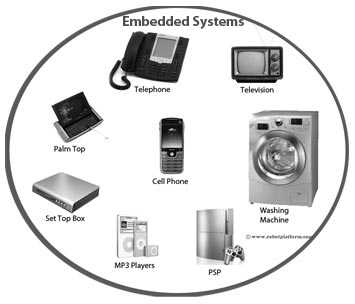Introduction to Robots & Robotics
We will start this tutorial by defining and understanding the meaning of robots and robotics. A Wikipedia definition of robot says "A robot is a mechanical contraption which can perform tasks on its own, or with guidance".
What are Robots?
The term robot is derived from Czech word “robota” which means work, or forced work. Nobody has ever given a precise explanation of what a robot is, although each of those definitions more or less means the same. To make things simpler, we can say that “Robot is a combination of electronics, mechanics and programming (non-programmable in some cases), which senses it’s surrounding through its sensors; processes the sensor information and does something in response”. The response can be locomotion or manipulation, like turning on a LED, rotating a wheel, moving an arm, raising an alarm and so on. The branch of computer science and engineering which deals with robot design, construction, application and operation is called Robotics with applications in computer science, physics, engineering, defense and even many household devices.
If the above robot definition is too difficult to digest, let us bring the definition down to its very basic level. “Any machine which is recognized by a normal human being as a robot can be considered a robot”.
Difference between Robots and Embedded systems
Embedded System: Embedded system is a combination of various electronic and mechanical parts which are designed to perform a particular task (or a set of few tasks) in real time with high efficiency and performance. These systems are used in various consumer electronics, medical systems, military applications, etc. Portable music player, cell phones are all examples of embedded systems which have a controller built in to perform specific activities.

Robots: Robots are theoretically different in that they are equipped with sensors to perceive their environment and actuators to perform particular tasks and can take intelligent decisions.
Although robots and embedded systems seem like two extremes of engineering world, the gap between them is reducing. We already know that washing machines can sense dirt in cloths and takes intelligent decisions. Air conditioners can sense outside temperature and adjust internal room temperature. These are intelligent embedded systems built inside another bigger system which perceives it environment through its sensors and takes corrective actions, thereby controlling the bigger system.
Since most beginners confuse embedded systems with robotics, we will keep embedded systems outside this tutorial and only use the terms “robots” and “robotics” for our discussions.
Where do I find Robots?
Robots are everywhere around us, but it just matters what we consider as robots. Cars that sense an emergency and apply brakes, motion detector that senses movement and raises an alarm, solar street light which senses direction of sun and turns towards it, are all robots in our real world although some of you may not consider these as robots. Few may not even consider remote controlled robots as robots because they are controlled by humans and the robot does not make any intelligent decisions.
To please a larger crowd, we will consider any machine that fulfils our robot definition as a robot
Who makes robots?
Robots are used in many fields like Automotive, Research, Manufacturing, Entertainment, Education etc. People from different backgrounds like Electrical, Mechanical, Computer Science and Electronic Engineers get together to plan, design and develop a robot based on the complexity of the robot. This does not mean others cannot build robots. The intention of this site is to make sure anybody can build robots.
There are three different types of people who build robots:
- A learner who wants to acquire more knowledge or follow someone who is building a robot. He/she can also do this just to complete a school project. Most of them in this category would not jump to the next level either due to lack of interest, or because other activities attract them more.
- Experienced folks make good use of what they have learnt. They make robots to simplify their work; few may build it for entertainment and fun. Few of them also build robots to acquire more knowledge and share what they have learnt. Hobbyist community stands somewhere in this category.
- A third category of people make a living from what they have learnt. This can be an individual, a community, or a commercial organization that makes and/or sells robots, robot parts, or even sell knowledge about robots in the form of books, online tutorials, conferences, etc.
(BTW, every information available in this site is completely free. All I am asking you is to spread a word about this site, contribute to the forum, and link back :)
So, why do we build robots?
Apart from the sheer thrill of building robots, there are many other interesting reasons:
- They reduce human effort
- Robots won’t get bored doing the same monotonous work every time
- They can get into dangerous places without complaining
- Lastly, they make lesser mistakes compared to humans (positively if your program is not buggy)

Three laws of Robotics
Even robots have laws and when you are building a robot, you are expected to keep these three laws in mind:
- A robot may not injure a human being or, through inaction, allow a human being to come to harm
- A robot must obey any orders given to it by human beings, except where such orders would conflict with the First Law
- A robot must protect its own existence as long as such protection does not conflict with the First or Second Law
Science fiction writer “Isaac Asimov” created these three laws and had frequently used them in his books. However in these days it may become impossible to implement these three laws because the robots existence depends on breaking these rules. Let us taken an example and understand how these laws are broken:
- Robots do not have true intelligence, but are built on artificial intelligence. These intelligent robots are used in military applications to hurt and/or destroy the opposition. Now, the first rule is ruled out.
- Second law is also broken in our first example. Suppose an intelligent missile is fired towards an opposition. Rule 2, first part says that the robot should obey human beings. No, it does not obey the opposition but kills them. Second part of rule 2? Well, the person is killed and we would not go further with the rule as it is already broken.
- Robots do exist and are protected by its manufacturers. Once they are open to the outside world, all the rules conflict with each other and … well, all the laws are broken.
We can still make our own rule while building robots and that rule should be “Robots are built to be like slaves and guardians. They should perform tasks which are monotonous, difficult or dangerous for humans to perform and are also expected to obey the orders given by its master”. Yes, only obey the orders given by the master, but not of each and every possible human being alive.
Robots in news
Let us discuss about a few robots that are getting into headlines in the robotic world.
Humanoids: Humanoid in robot context is a robot built to resemble human being. Through the years, they are many such robots build by different companies and research centers, and the popular ones Asimo, Android, Actroid, QRIO, Nao etc. (I wouldn’t go deep into the features of any of these robots as the information is easily available everywhere on the net).
Robot Pets: Aibo is one of those fascinating robot pets designed by Sony. For those who need a robot resembling your pet dog, get inspired by Aibo
Utility Robot: Roomba is an intelligent and autonomous vacuum cleaner made by iRobot. Their sleek yet intelligent design makes them a super interesting model in the hobbyist community.
The above list is just a tip of ice berg. As mentioned before, robots are everywhere; some very well identified and others stay muted within other systems, almost unrecognized.

Future of robots
The advancement in technology would bring a day of robots omnipresence. They will soon sneak everywhere from gadgets to apparels and to our very own bodies. Although the goal of building a robot with intellectual capabilities of a human is too far, autonomous robots that do our daily chores are not far. Let us wait and see what the future of robots has for us…
Do you have anything to say?
Visit the Forum to discuss, learn and share anything related to robotics and electronics !!








